小学英语教师资格证面试教案范文参考:Can I
- 格式:pdf
- 大小:74.90 KB
- 文档页数:3
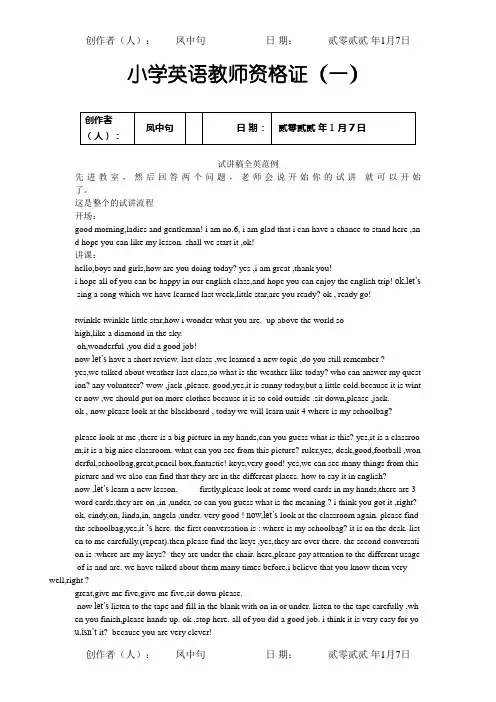
小学英语教师资格证(一)试讲稿全英范例先进教室,然后回答两个问题,老师会说开始你的试讲就可以开始了。
这是整个的试讲流程开场:good morning,ladies and gentleman! i am no.6, i am glad that i can have a chance to stand here ,and hope you can like my lesson. shall we start it ,ok!讲课:hello,boys and girls,how are you doing today? yes ,i am great ,thank you!i hope all of you can be happy in our english class,and hope you can enjoy the english trip! ok,let’ssing a song which we have learned last week,little star,are you ready? ok , ready go!twinkle twinkle little star,how i wonder what you are. up above the world sohigh,like a diamond in the sky.oh,wonderful ,you did a good job!now let’s have a short review. last class ,we learned a new topic ,do you still remember ?yes,we talked about weather last class,so what is the weather like today? who can answer my quest ion? any volunteer? wow ,jack ,please. good,yes,it is sunny today,but a little cold.because it is wint er now ,we should put on more clothes because it is so cold outside .sit down,please ,jack.ok , now please look at the blackboard , today we will learn unit 4 where is my schoolbag?please look at me ,there is a big picture in my hands,can you guess what is this? yes,it is a classroo m,it is a big nice classroom. what can you see from this picture? ruler,yes, desk,good,football ,won derful,schoolbag,great,pencil box,fantastic! keys,very good! yes,we can see many things from this picture and we also can find that they are in the different places. how to say it in english?now ,let’s learn a new lesson. firstly,please look at some word cards in my hands,there are 3 word cards,they are on ,in ,under, so can you guess what is the meaning ? i think you got it ,right?ok, cindy,on, linda,in, angela ,under. very good ! now,let’s look at the classroom again. please find the schoolbag,yes,it ‘s here. the first conversation is : where is my schoolbag? it is on the desk. list en to me carefully.(repeat).then please find the keys ,yes,they are over there. the second conversati on is :where are my keys? they are under the chair. here,please pay attention to the different usage of is and are. we have talked about them many times before,i believe that you know them very well,right ?great,give me five,give me five,sit down please.now let’s listen to the tape and fill in the blank with on in or under. listen to the tape carefully ,wh en you finish,please hands up. ok ,stop here. all of you did a good job. i think it is very easy for yo u,isn’t it? because you are very clever!how time flies,it is time to say goodbye. today’s homework is make some sentences with on,in ,un der ,and if you can,please teach your parents or your friends about the usage of on,in,under.ok,that is all for today,good bye,see you next time!篇二:讲课:hi ,my dear children!(good afternoon,boys and girls! hello,everyone!) it is nice to meet you aga in in the beautiful sunshine day. now ,let’s began our class! let us sing the song we have learnt bef ore.( 歌曲名字)wa~~ it is very beautiful. now we have some new friends here. who are they?ok,have a look. op en your books, and turn to page 100, look, who are they? what’s the matter with them?教师出示一支体温表,说:this is a thermometer. if i have a fever, it will tell me. let’s see mike. mike doesn’t feel well. he has a fever.指着let’s learn的图片的mike,教学“have a fe ver”。
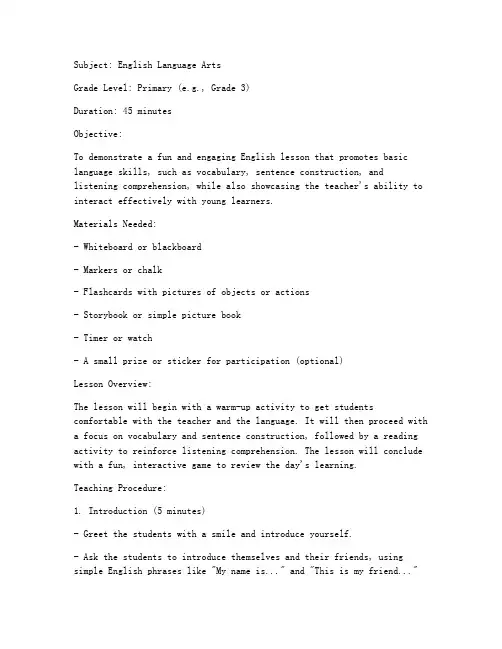
Subject: English Language ArtsGrade Level: Primary (e.g., Grade 3)Duration: 45 minutesObjective:To demonstrate a fun and engaging English lesson that promotes basic language skills, such as vocabulary, sentence construction, andlistening comprehension, while also showcasing the teacher's ability to interact effectively with young learners.Materials Needed:- Whiteboard or blackboard- Markers or chalk- Flashcards with pictures of objects or actions- Storybook or simple picture book- Timer or watch- A small prize or sticker for participation (optional)Lesson Overview:The lesson will begin with a warm-up activity to get students comfortable with the teacher and the language. It will then proceed with a focus on vocabulary and sentence construction, followed by a reading activity to reinforce listening comprehension. The lesson will conclude with a fun, interactive game to review the day's learning.Teaching Procedure:1. Introduction (5 minutes)- Greet the students with a smile and introduce yourself.- Ask the students to introduce themselves and their friends, using simple English phrases like "My name is..." and "This is my friend..."- Engage the students in a quick round of "Hello" to practice their pronunciation.2. Warm-Up Activity: Circle Time (10 minutes)- Begin with a simple circle time to review the weather, favorite colors, or a favorite animal.- Use flashcards with pictures to ask the students questions like "What is this?" and encourage them to respond in English.- Use simple vocabulary and phrases such as "red," "blue," "cat," "dog," and "happy."3. Vocabulary and Sentence Construction (15 minutes)- Introduce new vocabulary words related to the storybook or theme ofthe lesson.- Use flashcards to show the words and ask the students to repeat them.- Construct simple sentences using the new vocabulary, such as "I have a red ball" or "She likes to play with her dog."- Encourage students to create their own sentences with the new words.4. Reading Activity: Storytime (10 minutes)- Read a simple storybook or a passage from a picture book aloud to the class.- Pause at intervals to ask questions about the story, such as "What did the character do?" or "Why do you think they did that?"- Use gestures and facial expressions to make the story more engagingand to help students follow along.5. Interactive Game: Vocabulary Bingo (10 minutes)- Hand out bingo cards with the new vocabulary words on them.- Call out the words from the lesson and have students mark their cards if they have the word.- The first student to get a full line wins a small prize or sticker.6. Conclusion (5 minutes)- Review the vocabulary words learned during the lesson.- Ask the students to share what they liked most about the lesson.- Thank the students for their participation and encourage them to continue learning English at home.Assessment:- Observe the students' participation and engagement throughout the lesson.- Check the bingo cards to see if the students can recognize and use the new vocabulary words.- Evaluate the students' ability to construct simple sentences using the new vocabulary.Note:This lesson plan is a template and can be adapted to fit the specific needs and interests of the students. It is important to be flexible and responsive to the students' feedback and learning styles.。

英语教资面试教案设计优秀7篇英语教资面试教案设计【篇1】教学目标:1.会使用可数名词和不可数名词开购物单。
为后两课学习购物做准备。
2. 学会讨论吃什么饭,买什么东西。
3.复习一些礼貌用语和习惯表达,如:How about…? What about…? Can you come with me? What do you have for dinner this evening? Let me and have a look.等。
教学用具:录音机,实物投影仪,图片或实物等。
如有条件可做一商店的模型。
是的可更加生动真实。
教学步骤:Step 1 Revision[课件展示]值日生Duty Report。
教师让学生看图片编对话,两人一组操练对话。
同时教师总结售货员用语和顾客用语。
A: May I help you ?B: Thank you. I want …of …, please.A: Certainly. Here you are. Is that all?B: No. And some… please.A: How many do you want?B: About…, please.Step 2 Read and act[课件展示]教师可以点击图片播放影片让学生观看。
教师点击图标播放录音并让学生跟读。
让学生听录音一遍后问:Where are they?在听录音一遍后问学生: What does Tom want to buy? What else? How many? How much are they?听第三遍,模仿跟读,直至练熟。
Step 4 practice[课件展示]教师点击图片播放影片让学生观看,使学生模仿情景影片中的对话,学生可根据课件中提供的食品名称和重量,两人一组自行编对话。
有条件的班级可以让学生进行对话演练。
Step 5 Listen and answer[课件展示]教师点击图标播放录音,同时让学生观看课件中的问题,要求学生边听边记。
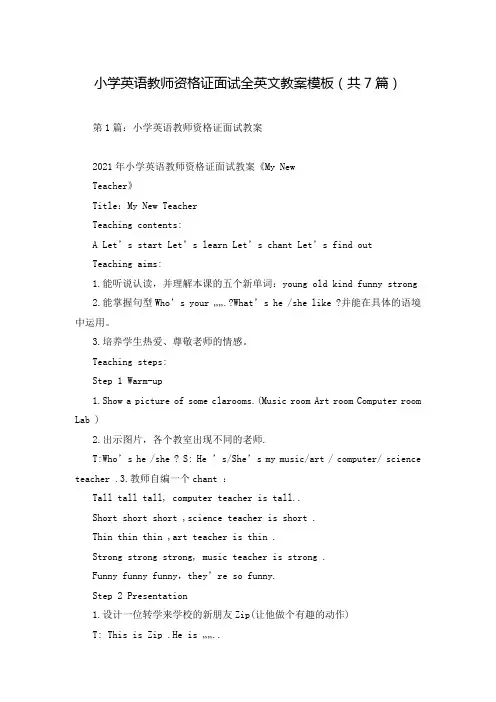
小学英语教师资格证面试全英文教案模板(共7篇)第1篇:小学英语教师资格证面试教案2021年小学英语教师资格证面试教案《My NewTeacher》Title:My New TeacherTeaching contents:A Let’s start Let’s learn Let’s chant Let’s find outTeaching aims:1.能听说认读,并理解本课的五个新单词:young old kind funny strong2.能掌握句型Who’s your …….?What’s he /she like ?并能在具体的语境中运用。
3.培养学生热爱、尊敬老师的情感。
Teaching steps:Step 1 Warm-up1.Show a picture of some clarooms.(Music room Art room Computer room Lab )2.出示图片,各个教室出现不同的老师.T:Who’s he /she ? S: He ’s/She’s my music/art / computer/ science teacher .3.教师自编一个chant :Tall tall tall, computer teacher is tall..Short short short ,science teacher is short .Thin thin thin ,art teacher is thin .Strong strong strong, music teacher is strong .Funny funny funny,they’re so funny.Step 2 Presentation1.设计一位转学来学校的新朋友Zip(让他做个有趣的动作)T: This is Zip .He is ……..S: Funny .T: Yes, he is funny.Do you like him ? This term he will be our new clamate.2.点击Zip, 让Zip介绍自己的学校和老师。
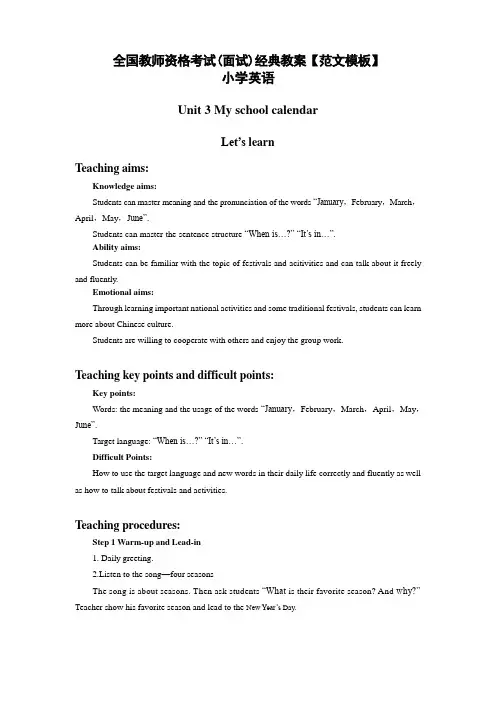
全国教师资格考试(面试)经典教案【范文模板】小学英语Unit 3 My school calendarLet’s learnTeaching aims:Knowledge aims:Students can master meaning and the pronunciation of the words “January,February,March,April,May,J une”.Students can master the sentence structure “When is…?”“It’s in…”.Ability aims:Students can be familiar with the topic of festivals and acitivities and can talk about it freely and fluently.Emotional aims:Through learning important national activities and some traditional festivals, students can learn more about Chinese culture.Students are willing to cooperate with others and enjoy the group work.Teaching key points and difficult points:Key points:Words: the meaning and the usage of the words “January,February,March,April,May,J une”.Target language: “When is…?”“It’s in…”.Difficult Points:How to use the target language and new words in their daily life correctly and fluently as well as how to talk about festivals and activities.Teaching procedures:Step 1 Warm-up and Lead-in1. Daily greeting.2.Listen to the song—four seasonsThe song is about seasons. Then ask students “What is their favorite season? And why?”Teacher show his favorite season and lead to the New Year’s Day.Step 2 PresentationShow the picture of school calendar and ask “what holidays or festivals can you think of?”Teacher collect some holidays and festivals. Then teach students the first six months by asking the following questions.a.When is the New Year’s Day?(It’s in January.)b. What day is in February?(Winter vacation.)c. When is the third month in a year? What day do we have in March?( Tree planning day)d. Do you know Easter? When is it? What do people do on Easter?(It’s inApril.)e. What days will we have in May?(We have Mother’s Day in May. )f. When is Children’s Day? Do you know Father’s Day?(It’s in June.)Step 2 Practice1. Play a speed gameShow some pictures of different festivals quick, and let sudents tell what day it is and when it is.2. Make a dialogueLet students work in pairs for a dialogue, ask and answer for different days in different months by using the target language.Step 3 Production1. Read and sayStudents do the tick and cross exercise on your book, if the sentences are inaccurate, please correct them. Then invite some students to read the right sentences one by one.2.Make calendarsDivide the whole class into five groups, every group have to make their own calendars, some activities, holidays and festivals need to be filled into the calendar. Some groups will be called to come to the front of the class to make a brief introduction of it.Step 4 Summary and homeworkSummary: The whole class review what we have learned together.Homework: Ask students to search for more festivals to fill in their calendar and introduce it to their friends.Black board design:Unit 3 My school calendarJanuary New Year’s DayFebruary Winter vacation When is…March Tree planning day It is…April EsterMay Mother’s DayJuneChildren’s DayUnit 3 Where did you go?Read and writeTeaching aims:Knowledge aims:Students can understand the meaning of the passage about Wu Yifan’s bad but good day.Students can master when to use the simple past tense correctly.Ability aims:Students can improve their reading skills of getting detailed information.Students can talk about their past things with partners.Emotional aims:Students are willing to share their life expirence with others and have an optimistic attitude towards life.Teaching key points and difficult points:Key points:Wu Yifan’s holiday experience.Difficult Points:How to apply the simple past tense correctly to talk about a past day.Teaching procedures:Step 1 Warm-up and Lead-in1.Review and sing the song-- Happy, happy holidayLet students stand up, clap thier hands and shake their body to sing the song, happy, happy holiday together.2. Free talkAsk them the question “What did you do for your holiday?” and “how do you feel about the holiday?” Teacher gives them reflections properly.Step 2 Presentation1.Show students the pictures about Wu Yifan’s holiday on the screen. Let students guess what Wu Yifan did for his holiday. Teacher can lead students by following questions.a. What happened to Wu Yifan’s mother?b. What did Max do to Robin?c. What did Wu Yifan’s family do for their holiday?2. Read Wu Yifan’s diary for the first time and try to write the right number of the pictures on the book.3. let students read the passage and think about “What happened to Wu Yifan’s family?”(Something bad but something good happened to them.). Fill in the blank in the text about”What were bad for them?”(Mom ate some bad fruit and didn’t feel well.)and “What were good for them?”(1.rode a bike2.took the pictures of beautiful countryside3.bought some gifts4. ate some delicious). Then call some volunteers to tell the answers in their own words.Step 2 PracticeGive students five minutes to think about a bad but good day of their own and write some sentences according to the following questions.a.Why was the day bad, what happened?b. Why was the good too, what happened?c. What do you learn from the day?At the same time, remind them to pay more attention to the simple past tense.Step 3 ProductionAsk students to share their bad but good day in a group of five and make a form to record the group member’s bad but good experience. Then let the representatives introduce it to the whole class.Step 4 Summary and homeworkSummary: Invite one of the students to be "a little teacher " and lead others to review what we have learned together.Homework: Ask students to write a dairy to record a past thing and share with others in the next period.Black board design:Unit 3 Where did you go?Wu YIfan’s day:Bad:Mom ate some badfruit and didn’t feel well.Good:1.rode a bike2.took the pictures ofbeautiful countrysideIt was a bad day but also a good day!。
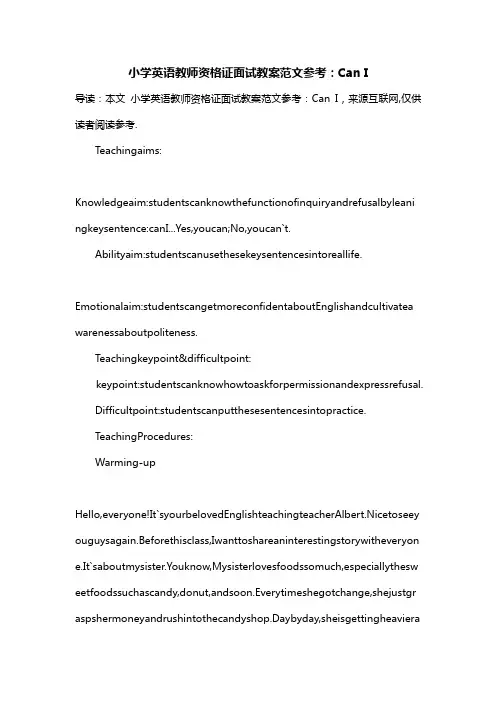
小学英语教师资格证面试教案范文参考:Can I导读:本文小学英语教师资格证面试教案范文参考:Can I,来源互联网,仅供读者阅读参考.Teachingaims:Knowledgeaim:studentscanknowthefunctionofinquiryandrefusalbyleani ngkeysentence:canI...Yes,youcan;No,youcan`t.Abilityaim:studentscanusethesekeysentencesintoreallife.Emotionalaim:studentscangetmoreconfidentaboutEnglishandcultivatea warenessaboutpoliteness.Teachingkeypoint&difficultpoint:keypoint:studentscanknowhowtoaskforpermissionandexpressrefusal.Difficultpoint:studentscanputthesesentencesintopractice.TeachingProcedures:Warming-upHello,everyone!It`syourbelovedEnglishteachingteacherAlbert.Nicetoseey ouguysagain.Beforethisclass,Iwanttoshareaninterestingstorywitheveryon e.It`saboutmysister.Youknow,Mysisterlovesfoodssomuch,especiallythesw eetfoodssuchascandy,donut,andsoon.Everytimeshegotchange,shejustgr aspshermoneyandrushintothecandyshop.Daybyday,sheisgettingheavierandheavier.Everytimesheaskedmymom“mommy,canIhavesomechangeforanicecream?”everytimemymotherwasdepressedandanswer“No,youcan`thoney”.ThenIwouldcan`thelplaughing.It`sinteresting,right ?Iguesssometimesyouguysalsohavesuchkindofrequest.Inordertoimprove yourskillforrequesting,letsstartournewclass.CanI...Pre-listeningNow,guys,lookatthescreen.Hereisapicture.Whatinit?Alex,youplease.Yes,Al exsaid“there`resomanyfoodsandalittlegirlwithhermom”.Goodjob.AsAlexsaid, canyouguyshaveaguess?Whataretheytalkingabout?Foods?Argument?Ok ,let’skeepitasariddle.Next,we`regoingtouncoverthisriddle.While-listeningNowwearegoingtolistentoatapefortwice.Duringthefirsttime,youguysnee dtocheckyourpredictionandanswermethatwhataretheytalkingabout.Arey ouready?Letsbegin.Ok,timetoanswermyquestion.Coco,youplease.Well,youstillthinkthattheya retalkingaboutfoods.Well,youmaysayso.Sitdownplease.Anyoneelse?Ok,T ina.Yousaythegirlisaskingforfoodfromhermother.Perfect!You`reverygoodatcatchinginformation.Ok,youtwodidareallygoodjob.Now,wearegoingtolistentothetapeagain.Afterlistening,youjustneedtoans wermyquestions.WhatdoesAmywant?WhatdoesAmyfinallyget?Ready?Go!Well,timeisup.Whocananswermyfirstquestion?WhatdoesAmywant?Good ,Nina,youplease.Well,NinasaidAmywantsdrinkandicecream.Excellent!You aresuchasmartgirl.Now,thesecondquestion.WhatdoesNinafinallyget?Chri stina,please.Brilliant!Biscuit,right.Iknowyoucandoit.Post-listeningWehavefinishedthistape.Theirconversationisquitinteresting,ha?Ijustthou ghtmysisterandmymom.Doyouguyswanttodoarole-play?Yes?Ok,twostud entsinonegroup.OneisAmy,theotherisAmy`smom.Letsdoarole-play.Youha ve3minutes.Afterthis,iwillinviteonegrouptoshowus.Well,timeisup.Volunteers?Ok,groupbanana.Verygood,yourperformanceis excellent.I`msoproudofyou.Summary&HomeworkTimeflies,it`salmosttheendofthisclass.Letsdoasimplesummarytogether.W hatwehavelearnedtoday?Yes,wehavelearnedhowtoaskforpermissionandexpressrefusal.Butremember,n omatterweaskforpermissionorexpressrefusal.Weneedkeeppolitebecause wearegoodkids,allright?Afterclass,ihopeyoucanaskforwhatyouwanttoeat formyourmom,butremember,inEnglish.Ok,classisover,seeyounexttime.。
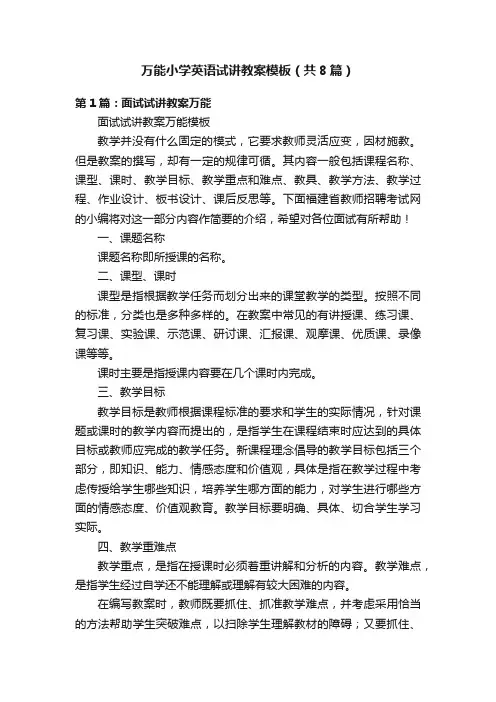
万能小学英语试讲教案模板(共8篇)第1篇:面试试讲教案万能面试试讲教案万能模板教学并没有什么固定的模式,它要求教师灵活应变,因材施教。
但是教案的撰写,却有一定的规律可循。
其内容一般包括课程名称、课型、课时、教学目标、教学重点和难点、教具、教学方法、教学过程、作业设计、板书设计、课后反思等。
下面福建省教师招聘考试网的小编将对这一部分内容作简要的介绍,希望对各位面试有所帮助!一、课题名称课题名称即所授课的名称。
二、课型、课时课型是指根据教学任务而划分出来的课堂教学的类型。
按照不同的标准,分类也是多种多样的。
在教案中常见的有讲授课、练习课、复习课、实验课、示范课、研讨课、汇报课、观摩课、优质课、录像课等等。
课时主要是指授课内容要在几个课时内完成。
三、教学目标教学目标是教师根据课程标准的要求和学生的实际情况,针对课题或课时的教学内容而提出的,是指学生在课程结束时应达到的具体目标或教师应完成的教学任务。
新课程理念倡导的教学目标包括三个部分,即知识、能力、情感态度和价值观,具体是指在教学过程中考虑传授给学生哪些知识,培养学生哪方面的能力,对学生进行哪些方面的情感态度、价值观教育。
教学目标要明确、具体、切合学生学习实际。
四、教学重难点教学重点,是指在授课时必须着重讲解和分析的内容。
教学难点,是指学生经过自学还不能理解或理解有较大困难的内容。
在编写教案时,教师既要抓住、抓准教学难点,并考虑采用恰当的方法帮助学生突破难点,以扫除学生理解教材的障碍;又要抓住、抓准教学重点,正确适当地处理好教材,以保证较好地达到教学目的。
五、教具教具又称教具准备,是指辅助教学手段使用的工具。
如多媒体、模型、标本、实物、音像等。
六、教学方法教学方法是指在教学过程中所使用的方法。
如课堂的提问、讨论、启发、自学、演示、演讲、辩论等。
七、教学过程教学过程,是教师为了实现教学目标、完成教学任务而制定的具体的教学步骤和措施。
教学过程是整个教案的核心和主体,编写时要根据教学目标及教材的具体情况,该详则详,该略则略,做到内容充实、重点突出、详略得当、利于教学。
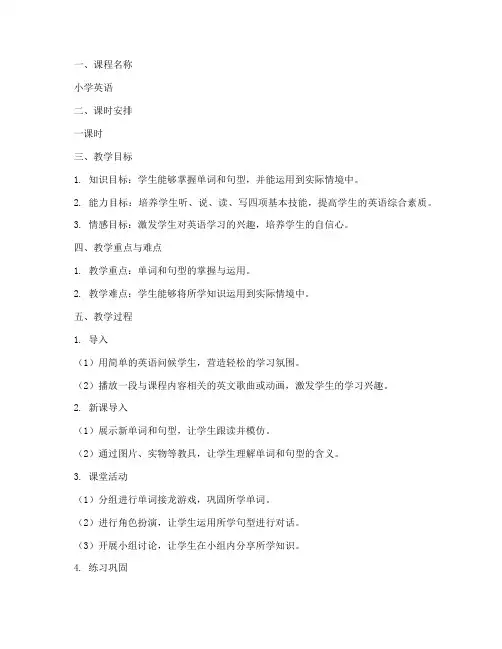
一、课程名称小学英语二、课时安排一课时三、教学目标1. 知识目标:学生能够掌握单词和句型,并能运用到实际情境中。
2. 能力目标:培养学生听、说、读、写四项基本技能,提高学生的英语综合素质。
3. 情感目标:激发学生对英语学习的兴趣,培养学生的自信心。
四、教学重点与难点1. 教学重点:单词和句型的掌握与运用。
2. 教学难点:学生能够将所学知识运用到实际情境中。
五、教学过程1. 导入(1)用简单的英语问候学生,营造轻松的学习氛围。
(2)播放一段与课程内容相关的英文歌曲或动画,激发学生的学习兴趣。
2. 新课导入(1)展示新单词和句型,让学生跟读并模仿。
(2)通过图片、实物等教具,让学生理解单词和句型的含义。
3. 课堂活动(1)分组进行单词接龙游戏,巩固所学单词。
(2)进行角色扮演,让学生运用所学句型进行对话。
(3)开展小组讨论,让学生在小组内分享所学知识。
4. 练习巩固(1)布置课后作业,让学生复习所学单词和句型。
(2)教师巡视课堂,个别辅导学生。
5. 总结(1)回顾本节课所学内容,强调重点和难点。
(2)鼓励学生课后继续学习,提高英语水平。
六、板书设计1. 单词:plane, boat, jeep, train, ...(根据实际教学内容添加)2. 句型:What can you see? I can see a ...七、教学反思1. 本节课是否达到了教学目标?2. 学生的学习效果如何?3. 教学过程中是否出现了问题,如何改进?八、教学资源1. 教材:人教版小学英语教材2. 教具:图片、实物、卡片、多媒体设备等注意事项:1. 教师应注重学生的个体差异,因材施教。
2. 创设生动有趣的教学情境,激发学生的学习兴趣。
3. 注重培养学生的英语实际运用能力。
4. 关注学生的学习情感,提高学生的自信心。
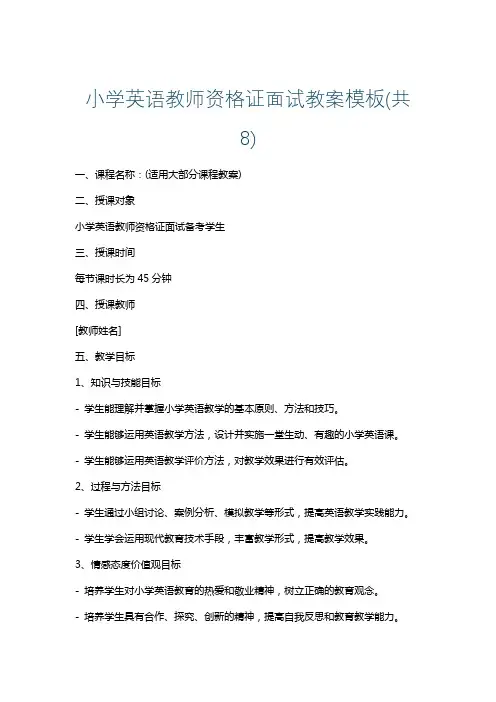
小学英语教师资格证面试教案模板(共8)一、课程名称:(适用大部分课程教案)二、授课对象小学英语教师资格证面试备考学生三、授课时间每节课时长为45分钟四、授课教师[教师姓名]五、教学目标1、知识与技能目标- 学生能理解并掌握小学英语教学的基本原则、方法和技巧。
- 学生能够运用英语教学方法,设计并实施一堂生动、有趣的小学英语课。
- 学生能够运用英语教学评价方法,对教学效果进行有效评估。
2、过程与方法目标- 学生通过小组讨论、案例分析、模拟教学等形式,提高英语教学实践能力。
- 学生学会运用现代教育技术手段,丰富教学形式,提高教学效果。
3、情感态度价值观目标- 培养学生对小学英语教育的热爱和敬业精神,树立正确的教育观念。
- 培养学生具有合作、探究、创新的精神,提高自我反思和教育教学能力。
六、教学重占和难点1、教学重点- 小学英语教学的基本原则、方法和技巧。
- 英语教学设计、实施与评价。
- 现代教育技术手段在英语教学中的应用。
2、教学难点- 如何针对小学生的年龄特点,设计富有吸引力、互动性强的英语教学活动。
- 如何在有限的课时内,实现教学目标,提高学生的英语实际运用能力。
- 如何运用英语教学评价方法,对教学效果进行客观、全面的评估。
七、教学过程1、导入新课(5分钟)- 教师以生动的故事、歌曲或游戏等方式引起学生的兴趣,为新课的学习营造轻松愉快的氛围。
- 通过提问或展示与新课相关的图片、视频等资源,激发学生的好奇心和求知欲。
- 确保导入环节简洁明了,与新知识紧密相关,为学生进入新知讲授做好铺垫。
2、新知讲授(20分钟)- 教师采用讲解、示范、互动问答等方法,系统传授小学英语教学的基本原则、方法和技巧。
- 结合具体教学案例,分析并解释如何在实际教学中应用这些原则和方法。
- 强调学生主动参与,鼓励提问和发表观点,确保学生对新知识的理解和吸收。
3、合作探究(15分钟)- 将学生分成小组,针对某一教学主题或问题进行讨论和探究。
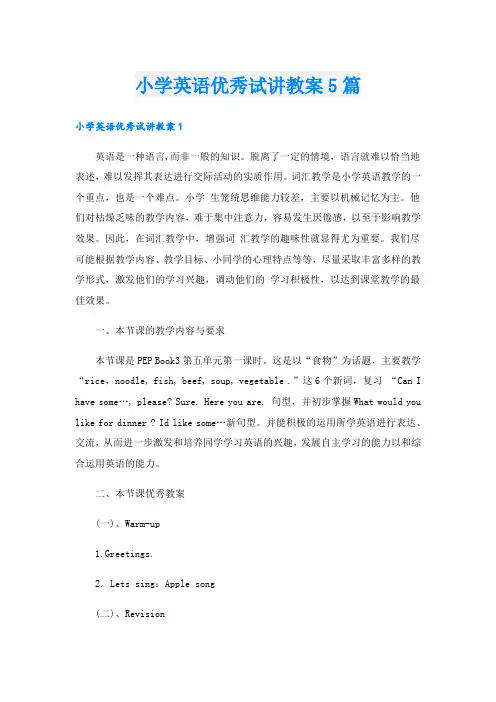
小学英语优秀试讲教案5篇小学英语优秀试讲教案1英语是一种语言,而非一般的知识。
脱离了一定的情境,语言就难以恰当地表述,难以发挥其表达进行交际活动的实质作用。
词汇教学是小学英语教学的一个重点,也是一个难点。
小学生笼统思维能力较差,主要以机械记忆为主。
他们对枯燥乏味的教学内容,难于集中注意力,容易发生厌倦感,以至于影响教学效果。
因此,在词汇教学中,增强词汇教学的趣味性就显得尤为重要。
我们尽可能根据教学内容、教学目标、小同学的心理特点等等,尽量采取丰富多样的教学形式,激发他们的学习兴趣,调动他们的学习积极性,以达到课堂教学的最佳效果。
一、本节课的教学内容与要求本节课是PEP Book3第五单元第一课时。
这是以“食物”为话题,主要教学“rice,noodle, fish, beef, soup, vegetable .”这6个新词,复习“Can I have some…, please? Sure. Here you are. 句型,并初步掌握What would you like for dinner ? Id like some…新句型。
并能积极的运用所学英语进行表达、交流,从而进一步激发和培养同学学习英语的兴趣,发展自主学习的能力以和综合运用英语的能力。
二、本节课优秀教案(一)、Warm-up1.Greetings.2. Lets sing:Apple song(二)、Revision1、Ask and answer:T: Good morning. Ss: Good morning.T: Whats your name? Ss: My name is ….T: How are you ? Ss: Fine, thank you.T: How old are you? Ss: I am 11.…2、Lead-inT: Look at the screen. This is my room. Whats this?Ss: Its a TV/sofa/shelf/fridge/bed…T: Do you like it?Ss: Yes, I do. / No, I dont.T: Then whats on the table?Ss: Eggs/Bread/Milk/Chicken/Juice/Hot dog/Hamburger…(用富有节奏的歌声将同学带入英语学习的乐园,调动同学的积极性,也为新的学习作好语言知识和情感态度上的准备。
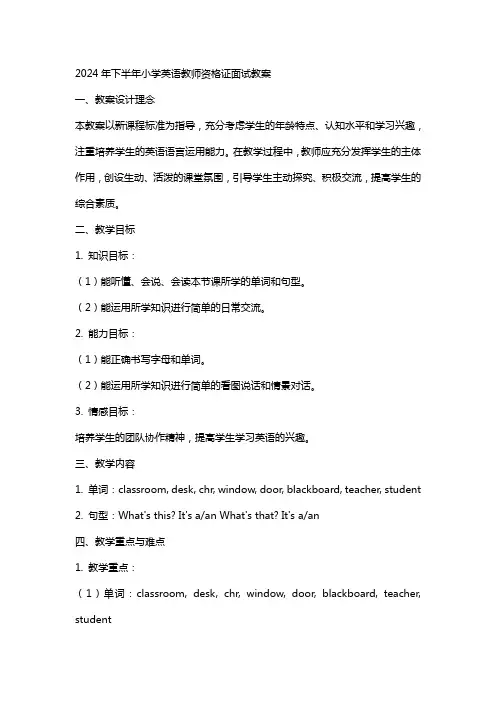
2024年下半年小学英语教师资格证面试教案一、教案设计理念本教案以新课程标准为指导,充分考虑学生的年龄特点、认知水平和学习兴趣,注重培养学生的英语语言运用能力。
在教学过程中,教师应充分发挥学生的主体作用,创设生动、活泼的课堂氛围,引导学生主动探究、积极交流,提高学生的综合素质。
二、教学目标1. 知识目标:(1)能听懂、会说、会读本节课所学的单词和句型。
(2)能运用所学知识进行简单的日常交流。
2. 能力目标:(1)能正确书写字母和单词。
(2)能运用所学知识进行简单的看图说话和情景对话。
3. 情感目标:培养学生的团队协作精神,提高学生学习英语的兴趣。
三、教学内容1. 单词:classroom, desk, chr, window, door, blackboard, teacher, student2. 句型:What's this? It's a/an What's that? It's a/an四、教学重点与难点1. 教学重点:(1)单词:classroom, desk, chr, window, door, blackboard, teacher, student(2)句型:What's this? It's a/an What's that? It's a/an2. 教学难点:(1)单词的准确发音。
(2)句型的运用。
五、教学方法与手段1. 教学方法:(1)情境教学法:通过创设真实、生动的情境,激发学生的学习兴趣,提高学生的语言运用能力。
(2)游戏教学法:通过趣味性强的游戏活动,巩固所学知识,提高学生的学习积极性。
(3)分组合作学习:培养学生的团队协作精神,提高学生的口语交流能力。
2. 教学手段:(1)多媒体课件:运用多媒体课件,直观展示教学内容,提高学生的学习兴趣。
(2)实物教具:运用实物教具,帮助学生直观理解单词和句型。
(3)录音机、磁带:播放英语听力材料,训练学生的听力能力。
面试英文教师试讲教案模板1. 教学目标本节课的主要目标是使学生能够掌握某个特定主题的基本英语表达能力,包括听、说、读、写四个方面。
通过本节课的教学,学生将能够用英语谈论该主题,加强他们的口语交际能力,并通过阅读和写作活动提高他们的阅读和写作能力。
2. 教学内容本节课的教学内容主要包括以下几个方面: - 主题:某个具体的话题(比如:旅行、食物、文化等) - 目标词汇和短语:列出与主题相关的基本词汇和短语 - 语法结构:列出与主题相关的基本语法结构 - 听力:听取与主题相关的短对话或短文,并回答问题 - 口语:通过角色扮演、对话等活动,练习使用目标词汇和语法结构进行口语表达 - 阅读:阅读与主题相关的短文,并回答问题 - 写作:通过填空、写小作文等活动,练习使用目标词汇和语法结构进行书面表达3. 教学步骤第一步:导入(5分钟)•创造一个引入主题的情境,引起学生的兴趣和好奇心。
•介绍本节课的教学目标,并告诉学生他们将要学习什么。
第二步:听力活动(10分钟)•播放与主题相关的短对话或短文,并给学生提问。
•学生听完后回答问题,检查他们的听力理解能力。
第三步:口语活动(15分钟)•分组进行角色扮演或对话活动,让学生运用目标词汇和语法结构进行口语表达。
•教师可以提供一些问题和示范对话,引导学生进行口语交流。
第四步:阅读活动(15分钟)•分发与主题相关的短文,并让学生阅读。
•学生阅读完毕后回答问题,检查他们的阅读理解能力。
第五步:写作活动(15分钟)•根据主题提供一个简单的写作任务,比如填空或写一个小作文。
•学生完成写作任务后交换作品,互相检查并进行修改。
第六步:总结(5分钟)•对本节课的内容进行总结,并回顾学生所学的目标词汇和语法结构。
•鼓励学生提出问题和表达自己的意见。
4. 教学资源•录音机/多媒体设备•与主题相关的短对话或短文•与主题相关的阅读材料•教师准备的口语活动和写作任务5. 教学评估•在听力、口语、阅读和写作活动中观察学生的表现,并记录他们的进步和需要改进的地方。
2024年下半年小学英语教师资格证面试教案一、教学目标1. 知识目标:让学生掌握基本的英语语法和词汇,能够进行简单的英语对话。
3. 情感目标:激发学生学习英语的兴趣,培养他们的自信心和合作精神。
二、教学内容1. 教学主题:我的日常生活2. 教学重点:一般现在时的用法,日常生活中的常用词汇和句型。
3. 教学难点:一般现在时的用法,动词的第三人称单数形式。
三、教学过程1. 热身活动(5分钟)教师与学生进行简单的英语对话,询问学生的生活情况,引导学生用英语进行回答。
2. 课堂导入(10分钟)教师通过展示图片或实物,引入主题“我的日常生活”,引导学生用英语描述图片或实物。
3. 新课呈现(15分钟)教师通过PPT或实物展示,介绍一般现在时的用法,以及日常生活中的常用词汇和句型。
引导学生进行模仿和练习。
4. 课堂活动(20分钟)教师组织学生进行小组活动,让学生运用所学知识进行对话交流,鼓励学生主动表达自己的观点。
5. 巩固练习(10分钟)教师出示一些练习题,让学生进行书面练习,巩固所学知识。
6. 课堂小结(5分钟)7. 课后作业(课后自主完成)学生根据课堂所学,编写一篇关于自己日常生活的短文,尽量运用所学词汇和句型。
四、教学评价1. 课堂表现:观察学生在课堂上的参与程度、发音准确性以及语言运用能力。
2. 练习完成情况:检查学生课后作业的完成质量,以及对课堂所学知识的掌握程度。
3. 学生自评:学生对自己的学习情况进行评价,包括学习态度、努力程度和收获等。
五、教学资源1. PPT课件:展示图片、文字和动画,生动形象地呈现教学内容。
2. 实物教具:用于展示和引导学生进行观察和描述。
3. 练习题:用于巩固所学知识,提高学生的书面表达能力。
4. 录音机、音响等设备:用于播放英语歌曲或对话,增加学生的听觉输入。
六、教学策略1. 任务型教学法:通过设计各种真实的任务,让学生在完成任务的过程中运用英语,提高他们的语言运用能力。
教师资格面试教案模板-英语篇第一部分:理论知识教案是教师据课程标准教学大纲和教科书要求及学生的实际情况,以课时或课题为单位,对教学内容、教学步骤、教学方法等进行的具体设计和安排的一种实用性教学文书。
教案主要包括六个部分:一、课题二、教学目标三、教学重难点四、教学方法五、教学过程六、板书设计下面对每一部分进行详解:一、课题打印的试题清单上有介绍题目是什么,直接把题目内容抄上即可。
二、教学目标确定的依据:知识点+课型+基本要求(试题清单)书写格式:学生时间、场所具体且可测量的质量效果(1)知识目标(Knowledge aim),即学生本节课可以获得什么知识。
语音教学:(Students will)get to know how to pause/the rules of(stop/raising tone)...口语教学:(Students will)understand the new words such as..and the new sentence pattern...听力教学:(Students can)understand the listening material/get the main idea of the listening material...词汇教学:(Students can)read/understand the new words correctly and understand their meaning.阅读教学:(Students will)be able to grasp/understand/get familiar with/analyze the main idea of this passage.(2)能力目标(Ability aim),即通过学习,学生可以掌握何种技能。
语音教学:(Students can)pronounce/speak out/read/the words correctly and apply/use/the rules of...correctly口语教学:(Students will)be able to use/make use of the...to make conversation freely/to talk about...(topic)/ express...freely/use...to describe/discuss...阅读教学:(Students will)learn to read the passage by skimming and scanning/get the main idea by using key words orkey sentences...听力教学:(Students can)understand the detailed information of this passage/improve listening ability...词汇教学:(Students can)use/pronounce/spell memorize the words correctly/apply the words in a correct way...(3)情感目标(Emotional aim)Students will cherish....Students can develop/improve...Students will like/be interested in...如:What is she like?(听力课)1.Teaching aims1)Knowledge aimStudents will be able to understand the words and sentences,such as teacher,like,sometimes;what is she like...2)Ability aimsa)Students will be able to train their listening skills.b)Students will know how to express somebody's character.3)Emotional aimStudents will develop the spirit of cooperation.二、教学重难点教学重点教学难点定义最基本、最重要、必须掌握的知识。
小学英语面试教案(优秀3篇)小学英语面试教案:Unit 1 How can I get there 篇一Teaching Aims:Knowledge aim: students can use these words to express where the place is :behind, beside, in front of...Ability aim: Students can use the words and sentences in real circumstancesEmotional aim: Students can enjoy the study of different weather in different places.Teaching important and difficult points:Important point: Students can master the pronunciation and the meaning of the new words and can master the usage of the sentence.Difficult point: Students can use the words and sentences in real circumstancesTeaching MethodsTask based teaching method (任务型教学法)Audio-lingual approach (听说法)Total physical response(全身反应法)Situational teaching method(情景教学法)Teaching Aidspictures,tape recorder, PPT.Teaching Procedures:Step 1: warming upPlay a game: listen and do. (review the words: go straight, turn left, turn right)Step 2: presentationTeach : map, pass, GPS, stars and a new feature.Show the picture about the words, and ask some questions:Q1: If we get lost. What should we do? What can we use?Q2: Where can we see GPS?Q3: What can robot do?[page]2. Read the passage underline the words we can’t understand it and order.gave, follow me, far, my new GPS, works3. Read the text in group, and answer the questions.(1) What’s Robin’s new feature?(2) How many places did they pass by?(3) Which word under the fourth picture means “奏效,起作用”?4. Fill in the blanks. Then retell the story.5. Can you read?(Tips for pronunciation)Step 3 : Consolidation1.Play a game: Where is it? (act a robot has GPS)Group 1 and 2: write the name of places 1Group 3 and 4 : write the name of places 2Group 3: write: beside, in front of ...E.g. : The hospital is next to the cinema2. Do workbookStep 4:Homework1. Listen to the tape and read the text.2. Use the new words make two sentences.Blackboard design小学英语面试教案:My Birthday 篇二Hello, boys and girls. How are you today? Yes, I am great. Thank you! I hope all of you can be happy in our English class. Before we start our new lesson, let’s sing the apple song we have learned last week. Okay, ready. Go. Apple round, apple red, apple juicy, apple sweet, apple I love you, apple sweet I love to eat. Oh, Wonderful, you did a great job.(lead-in)Now let’s have a short review. Last week, we learned a new topic, do you still remember? Right, we talked about birthday last week. And we also have learned some months. January, February, and May etc.Everybody, do you like to celebrate your birthday? Yes, of course, everyone likes it. Why? Who can tell me the reason? Okay, the tall boy in black coat. What’s your answer? You can get presents. Well done! Please have your seat. But we must tell others when is our birthday. So they can celebrate it for me. Do you think so?(presentation)Now boys and girls, Close your book. We will listen to the tape together. While you are listening, try to answer the question on the screen.1)When is the National Day?2)When is Zhang Peng’s birthday?3)When is John’s birthday?Can you hear it? Okay, I will make it louder. What about now? Fine. Now let’s start.You have listened to the tape. Can you tell me what’s the answer for question No.1? Any volunteers? Good, that girl please. October fist. Well done. You are so clever. Please sit down. So our National Day is October first. Boys and girls, please look at the card in my hand. And read after me. First, first, first. Wonderful. Now the first row. Everybody. Please read this word one by one. Fantastic. The next boy. Okay, louder please. Now is better. Look at my mouth. First, first. October first, lessen first. Very good. You have improved a lot!Now let’s move to the next question. Does any one know the answer? Good, that tall boy, please. May sad? That’s very close. Take it easy. Let’s listen one more time about this question. Okay, try it one more time, when is Zhang Peng’s birthday? Great! May second. You have improved a lot. Please sit down. Boys and girls, please look at the card in my hand. Second. Now read after me, second. Second, second, lesson 2 the second lesson. Well done! Now we’ll have two groups, when I show the first card, all the boys read it. And when I show the second card, all the girls read it. Are you clear? Now let’s begin! Brilliant!Let’s e to the last question. Who knows the answer? Okay, that girl in the back. June third. Super! Please take your seat! Everybody, look at the card and read after me. Third third third. Very good. When you pronounce this word. Put your the tip of your tongue between your teeth, like this. Third. Third. Very good.(consolidation)Boys and girls. Work in pairs and ask your partner question “When is your birthday”。
Introduction:This English teaching plan is designed for the primary school teacher qualification interview. It provides a comprehensive structure for candidates to prepare and deliver an effective teaching demonstration. The plan includes key components such as teaching aims, teaching key points, teaching difficult points, teaching procedures, and assessment methods. This template is intended to guide candidates in crafting a well-organized and engaging lesson plan.Teaching Objectives:1. To familiarize candidates with the structure and content of an effective English lesson plan.2. To develop candidates' ability to communicate in English during the interview.3. To showcase candidates' understanding of primary school English teaching methodologies.Teaching Aims:1. Knowledge aims:a. Candidates should be able to demonstrate their knowledge of English grammar, vocabulary, and pronunciation.b. Candidates should be able to explain the purpose and structure of various English language activities.2. Ability aims:a. Candidates should be able to create an engaging and interactive learning environment.b. Candidates should be able to adapt teaching strategies to cater to diverse learning styles and abilities.3. Emotional aims:a. Candidates should be able to demonstrate enthusiasm and confidence in their teaching abilities.b. Candidates should be able to foster a positive and supportive learning atmosphere.Teaching Key Points:1. Lesson structure: Candidates should be familiar with the 3P model (Preparation, Presentation, Practice) and the PWP model (Presentation, Practice, Writing).2. Language skills: Candidates should focus on teaching reading, writing, listening, and speaking skills.3. Teaching methods: Candidates should be aware of various teaching methods, such as TPR (Total Physical Response), storytelling, and group activities.Teaching Difficult Points:1. Adapting teaching strategies to different learning styles and abilities.2. Maintaining a positive and engaging learning atmosphere.3. Integrating technology into the teaching process.Teaching Procedures:1. Introduction (5 minutes)a. Briefly introduce the topic and purpose of the lesson.b. Establish rapport with the imaginary students.2. Warming-up (5 minutes)a. Use a song, rhyme, or game to engage the imaginary students.b. Review previous lesson content to activate prior knowledge.3. Presentation (10 minutes)a. Introduce new vocabulary and grammar points using visual aids, realia, or multimedia resources.b. Demonstrate the correct pronunciation and usage of new words and phrases.4. Practice (10 minutes)a. Engage the imaginary students in various language activities, such as pair work, group work, and role-play.b. Monitor and provide feedback to ensure students are actively participating and understanding the lesson content.5. Production (10 minutes)a. Guide the imaginary students to apply the new language in a real-life context.b. Provide opportunities for students to practice speaking andwriting skills.6. Summary (5 minutes)a. Review the main points of the lesson.b. Encourage the imaginary students to reflect on their learning experience.7. Homework (5 minutes)a. Assign relevant homework to reinforce the lesson content.b. Provide clear instructions and due dates.Assessment Methods:1. Observation: Assess candidates' ability to engage and manage the imaginary students throughout the lesson.2. Questioning: Evaluate candidates' knowledge of English language concepts and teaching strategies.3. Self-assessment: Candidates should reflect on their teaching performance and identify areas for improvement.Conclusion:This English teaching plan template is designed to assist candidates in preparing for the primary school teacher qualification interview. By following this structure, candidates can present a well-organized and engaging lesson that highlights their teaching abilities and knowledge. Good luck with your interview!。
教师资格证小学英语笔试教案模板(共4篇)第1篇:小学英语教师资格证面试教案2021年小学英语教师资格证面试教案《My NewTeacher》Title:My New TeacherTeaching contents:A Let’s start Let’s learn Let’s chant Let’s find outTeaching aims:1.能听说认读,并理解本课的五个新单词:young old kind funny strong2.能掌握句型Who’s your …….?What’s he /she like ?并能在具体的语境中运用。
3.培养学生热爱、尊敬老师的情感。
Teaching steps:Step 1 Warm-up1.Show a picture of some clarooms.(Music room Art room Computer room Lab )2.出示图片,各个教室出现不同的老师.T:Who’s he /she ? S: He ’s/She’s my music/art / computer/ science teacher .3.教师自编一个chant :Tall tall tall, computer teacher is tall..Short short short ,science teacher is short .Thin thin thin ,art teacher is thin .Strong strong strong, music teacher is strong .Funny funny funny,they’re so funny.Step 2 Presentation1.设计一位转学来学校的新朋友Zip(让他做个有趣的动作)T: This is Zip .He is ……..S: Funny .T: Yes, he is funny.Do you like him ? This term he will be our new clamate.2.点击Zip, 让Zip介绍自己的学校和老师。